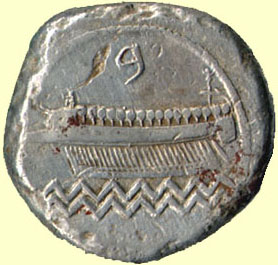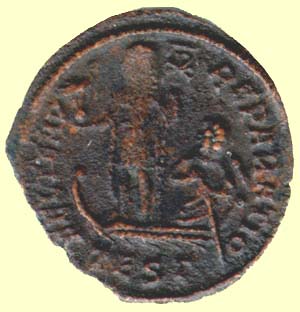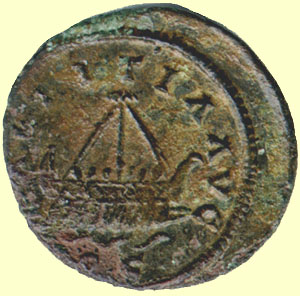
A Short Picture Gallery of Ships on Ancient Coins
One of the greatest advances in naval technology was the development of the trireme by Mediterranean civilizations about the year 500 B. C. Earlier ships had a single row of oars along each side, severely limiting the number of oars and rowers a ship could carry before the limits of length were reached. The trireme seated five men on three rowing benches. One thranite on top pulled the topmost oar in each set of three. Two zugites on the middle level benches pulled an oar together which was beneath and behind the thranite's oar. Two thalamites on the bottom bench pulled the bottom oar, also slightly behind the oar above it. The coin al left, a double shekel issued by the city of Tyre in about 325 B. C. depicts a Phoenician trireme of the period used in both commerce and war.
The early Greek trireme was a slim and graceful vessel, with a long stern curving up in back like the tail of a scorpion and a copper reinforced ram in the bow for punching holes in an enemy vessel's hull. The trireme was such a dramatic advance in naval technology that the Phoenicians and other Mediterranean peoples soon after the Greeks developed it
 The Romans were quick to adopt and improve upon the technology of other peoples with which they came in contact, and this was especially true in the matter of shipbuilding. By the time of the first war with Carthage, the standard warship type was the Quinquireme, or vessel with oars in groups of five. Tactics with the quinquireme were well - developed and based almost entirely on maneuvering the ram into position to either hole the enemy hull, break the enemy ship in two, or shear off the enemy ship's oars along one side. In the naval war with Carthage between 264 and 241 B. C., the Romans developed a hinged, movable gangplank to drop on an enemy's deck and allow Roman infantry to board her. This weapon, named the corvus after the Latin word for crow, was equipped with a sharp beak to hold it to an enemy vessel's deck. The Romans never really liked naval warfare, so they tried to make a sea battle as much like a land battle as possible. The coin at right has a stylized image of a Roman emperor standing in a warship steered by an allegorical figure representing Victory.
The Romans were quick to adopt and improve upon the technology of other peoples with which they came in contact, and this was especially true in the matter of shipbuilding. By the time of the first war with Carthage, the standard warship type was the Quinquireme, or vessel with oars in groups of five. Tactics with the quinquireme were well - developed and based almost entirely on maneuvering the ram into position to either hole the enemy hull, break the enemy ship in two, or shear off the enemy ship's oars along one side. In the naval war with Carthage between 264 and 241 B. C., the Romans developed a hinged, movable gangplank to drop on an enemy's deck and allow Roman infantry to board her. This weapon, named the corvus after the Latin word for crow, was equipped with a sharp beak to hold it to an enemy vessel's deck. The Romans never really liked naval warfare, so they tried to make a sea battle as much like a land battle as possible. The coin at right has a stylized image of a Roman emperor standing in a warship steered by an allegorical figure representing Victory.
 During the latter part of the Third Century A. D., Rome had her empire well established. The remote island of Britain was a province of the Roman Empire, and there was a permanent Roman fleet stationed in the English Channel to deal with Saxon and other barbarian pirates. The British usurper Carausius was originally in command of this fleet and decided to rebel in A. D. 283. The man who succeeded him on the throne of the rebel empire of Britain was Allectus, and the coin at left was issued by him. It depicts one of the ships of the Saxon Shore fleet at that time.
During the latter part of the Third Century A. D., Rome had her empire well established. The remote island of Britain was a province of the Roman Empire, and there was a permanent Roman fleet stationed in the English Channel to deal with Saxon and other barbarian pirates. The British usurper Carausius was originally in command of this fleet and decided to rebel in A. D. 283. The man who succeeded him on the throne of the rebel empire of Britain was Allectus, and the coin at left was issued by him. It depicts one of the ships of the Saxon Shore fleet at that time.
Return to Transportation Timeline
 The Romans were quick to adopt and improve upon the technology of other peoples with which they came in contact, and this was especially true in the matter of shipbuilding. By the time of the first war with Carthage, the standard warship type was the Quinquireme, or vessel with oars in groups of five. Tactics with the quinquireme were well - developed and based almost entirely on maneuvering the ram into position to either hole the enemy hull, break the enemy ship in two, or shear off the enemy ship's oars along one side. In the naval war with Carthage between 264 and 241 B. C., the Romans developed a hinged, movable gangplank to drop on an enemy's deck and allow Roman infantry to board her. This weapon, named the corvus after the Latin word for crow, was equipped with a sharp beak to hold it to an enemy vessel's deck. The Romans never really liked naval warfare, so they tried to make a sea battle as much like a land battle as possible. The coin at right has a stylized image of a Roman emperor standing in a warship steered by an allegorical figure representing Victory.
The Romans were quick to adopt and improve upon the technology of other peoples with which they came in contact, and this was especially true in the matter of shipbuilding. By the time of the first war with Carthage, the standard warship type was the Quinquireme, or vessel with oars in groups of five. Tactics with the quinquireme were well - developed and based almost entirely on maneuvering the ram into position to either hole the enemy hull, break the enemy ship in two, or shear off the enemy ship's oars along one side. In the naval war with Carthage between 264 and 241 B. C., the Romans developed a hinged, movable gangplank to drop on an enemy's deck and allow Roman infantry to board her. This weapon, named the corvus after the Latin word for crow, was equipped with a sharp beak to hold it to an enemy vessel's deck. The Romans never really liked naval warfare, so they tried to make a sea battle as much like a land battle as possible. The coin at right has a stylized image of a Roman emperor standing in a warship steered by an allegorical figure representing Victory.
 During the latter part of the Third Century A. D., Rome had her empire well established. The remote island of Britain was a province of the Roman Empire, and there was a permanent Roman fleet stationed in the English Channel to deal with Saxon and other barbarian pirates. The British usurper Carausius was originally in command of this fleet and decided to rebel in A. D. 283. The man who succeeded him on the throne of the rebel empire of Britain was Allectus, and the coin at left was issued by him. It depicts one of the ships of the Saxon Shore fleet at that time.
During the latter part of the Third Century A. D., Rome had her empire well established. The remote island of Britain was a province of the Roman Empire, and there was a permanent Roman fleet stationed in the English Channel to deal with Saxon and other barbarian pirates. The British usurper Carausius was originally in command of this fleet and decided to rebel in A. D. 283. The man who succeeded him on the throne of the rebel empire of Britain was Allectus, and the coin at left was issued by him. It depicts one of the ships of the Saxon Shore fleet at that time.